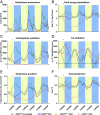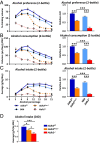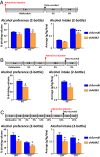Targeting liver aldehyde dehydrogenase-2 prevents heavy but not moderate alcohol drinking
- PMID: 31792171
- PMCID: PMC6926021
- DOI: 10.1073/pnas.1908137116
Targeting liver aldehyde dehydrogenase-2 prevents heavy but not moderate alcohol drinking
Abstract
Aldehyde dehydrogenase 2 (ALDH2), a key enzyme for detoxification the ethanol metabolite acetaldehyde, is recognized as a promising therapeutic target to treat alcohol use disorders (AUDs). Disulfiram, a potent ALDH2 inhibitor, is an approved drug for the treatment of AUD but has clinical limitations due to its side effects. This study aims to elucidate the relative contribution of different organs in acetaldehyde clearance through ALDH2 by using global- (Aldh2-/-) and tissue-specific Aldh2-deficient mice, and to examine whether liver-specific ALDH2 inhibition can prevent alcohol-seeking behavior. Aldh2-/- mice showed markedly higher acetaldehyde concentrations than wild-type (WT) mice after acute ethanol gavage. Acetaldehyde levels in hepatocyte-specific Aldh2 knockout (Aldh2Hep-/-) mice were significantly higher than those in WT mice post gavage, but did not reach the levels observed in Aldh2-/- mice. Energy expenditure and motility were dramatically dampened in Aldh2-/- mice, but moderately decreased in Aldh2Hep-/- mice compared to controls. In the 2-bottle paradigm and the drinking-in-the-dark model, Aldh2-/- mice drank negligible volumes from ethanol-containing bottles, whereas Aldh2Hep-/- mice showed reduced alcohol preference at high but not low alcohol concentrations. Glial cell- or neuron-specific Aldh2 deficiency did not affect voluntary alcohol consumption. Finally, specific liver Aldh2 knockdown via injection of shAldh2 markedly decreased alcohol preference. In conclusion, although the liver is the major organ responsible for acetaldehyde metabolism, a cumulative effect of ALDH2 from other organs likely also contributes to systemic acetaldehyde clearance. Liver-targeted ALDH2 inhibition can decrease heavy drinking without affecting moderate drinking, providing molecular basis for hepatic ALDH2 targeting/editing for the treatment of AUD.
Keywords: acetaldehyde; alcohol metabolism; alcohol use disorder; neuron; shAldh2.
Conflict of interest statement
The authors declare no competing interest.
Figures






Comment in
-
Reply to Brewer: Liver-targeted ALDH2 inhibition may reduce alcohol-seeking behaviors with limited side effects.Proc Natl Acad Sci U S A. 2020 Apr 7;117(14):7573-7574. doi: 10.1073/pnas.2001049117. Epub 2020 Mar 3. Proc Natl Acad Sci U S A. 2020. PMID: 32127485 Free PMC article. No abstract available.
-
Partial ALDH inhibition to facilitate controlled drinking rather than abstinence has already been tried and it works.Proc Natl Acad Sci U S A. 2020 Apr 7;117(14):7572. doi: 10.1073/pnas.2000318117. Epub 2020 Mar 3. Proc Natl Acad Sci U S A. 2020. PMID: 32127486 Free PMC article. No abstract available.
Similar articles
-
Alcohol metabolism in alcohol use disorder: a potential therapeutic target.Alcohol Alcohol. 2024 Jan 11;59(1):agad077. doi: 10.1093/alcalc/agad077. Alcohol Alcohol. 2024. PMID: 37950904 Free PMC article. Review.
-
Coordinated action of a gut-liver pathway drives alcohol detoxification and consumption.Nat Metab. 2024 Jul;6(7):1380-1396. doi: 10.1038/s42255-024-01063-2. Epub 2024 Jun 20. Nat Metab. 2024. PMID: 38902331
-
Effects of "Essential AD2" Supplement on Blood Acetaldehyde Levels in Individuals Who Have Aldehyde Dehydrogenase (ALDH2) Deficiency.Am J Ther. 2019 Sep/Oct;26(5):583-588. doi: 10.1097/MJT.0000000000000744. Am J Ther. 2019. PMID: 29509552 Clinical Trial.
-
Aldehyde dehydrogenase 2 gene targeting mouse lacking enzyme activity shows high acetaldehyde level in blood, brain, and liver after ethanol gavages.Alcohol Clin Exp Res. 2005 Nov;29(11):1959-64. doi: 10.1097/01.alc.0000187161.07820.21. Alcohol Clin Exp Res. 2005. PMID: 16340452
-
The UChA and UChB rat lines: metabolic and genetic differences influencing ethanol intake.Addict Biol. 2006 Sep;11(3-4):310-23. doi: 10.1111/j.1369-1600.2006.00030.x. Addict Biol. 2006. PMID: 16961761 Review.
Cited by
-
Diindoles produced from commensal microbiota metabolites function as endogenous CAR/Nr1i3 ligands.Nat Commun. 2024 Mar 22;15(1):2563. doi: 10.1038/s41467-024-46559-3. Nat Commun. 2024. PMID: 38519460 Free PMC article.
-
Alcohol metabolism in alcohol use disorder: a potential therapeutic target.Alcohol Alcohol. 2024 Jan 11;59(1):agad077. doi: 10.1093/alcalc/agad077. Alcohol Alcohol. 2024. PMID: 37950904 Free PMC article. Review.
-
Gut-liver highway of ALDH2 in drinking.Nat Metab. 2024 Jul;6(7):1202-1203. doi: 10.1038/s42255-024-01071-2. Nat Metab. 2024. PMID: 38902330 No abstract available.
-
Primum Non Nocere: Should Gene Therapy Be Used to Prevent Potentially Fatal Disease but Enable Potentially Destructive Behavior?Hum Gene Ther. 2021 Jun;32(11-12):529-534. doi: 10.1089/hum.2021.039. Epub 2021 Apr 26. Hum Gene Ther. 2021. PMID: 33752441 Free PMC article.
-
Alcoholic liver disease: a new insight into the pathogenesis of liver disease.Arch Pharm Res. 2022 Jul;45(7):447-459. doi: 10.1007/s12272-022-01392-4. Epub 2022 Jun 27. Arch Pharm Res. 2022. PMID: 35761115 Review.
References
-
- Fuster D., Samet J. H., Alcohol use in patients with chronic liver disease. N. Engl. J. Med. 379, 1251–1261 (2018). - PubMed
-
- Caputo F., Domenicali M., Bernardi M., Diagnosis and treatment of alcohol use disorder in patients with end-stage alcoholic liver disease. Hepatology 70, 410–417 (2019). - PubMed
MeSH terms
Substances
LinkOut - more resources
Full Text Sources
Other Literature Sources
Medical
Molecular Biology Databases
Miscellaneous

